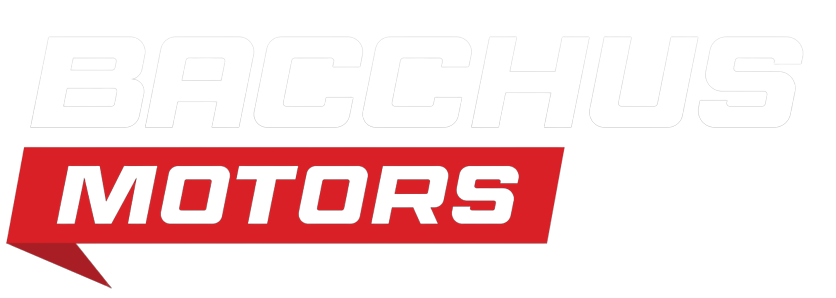
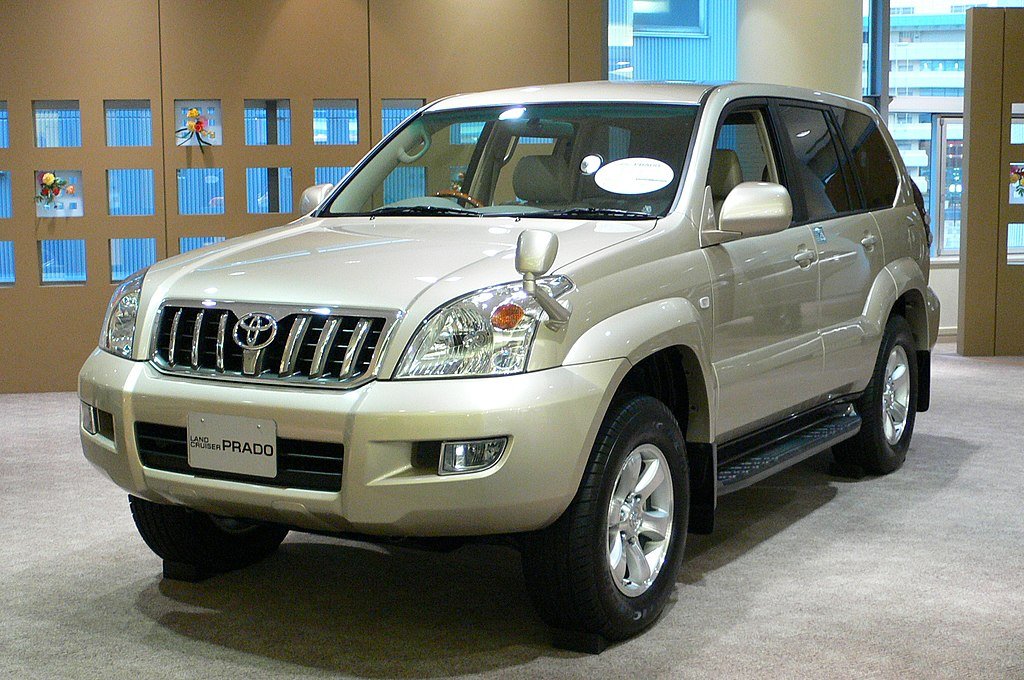
Buying a Used Toyota Prado J120 in Kenya
If you ask ten Kenyan SUV owners to name a dependable workhorse that still turns heads, at least half will say “Prado”—and many will mean the Toyota Land Cruiser Prado J120 (2002–2009). It’s the shape you still see gliding through Nairobi traffic, climbing out of muddy shambas in the rainy season, or queuing at the gates of national parks. The J120 has earned its stripes by blending authentic off-road ability with the comfort and polish families and executives want for daily life.
Buying one used can be a masterstroke—or a money pit—depending on how carefully you choose. The Kenyan market has everything from pampered, low-mileage imports to hard-worked units with knocked suspensions and tired injectors. This guide gives you the full picture: what the J120 is, why it’s loved, how to inspect it, the common problems to know, realistic price bands, alternatives to consider, and practical buying tactics for our local market. If you’re eyeing a J120, this is your roadmap to a smart, confident purchase.
Table of Contents
Toggle2) The Toyota Prado J120 at a Glance
The J120 succeeded the J90 series and passed the baton to the J150. Toyota didn’t overcomplicate the recipe: a body-on-frame SUV, strong drivetrains, and suspension engineered to survive corrugations and potholes. Design-wise it’s boxy and upright—classic SUV, not a soft crossover—with good visibility and a commanding driving position.
Typical trims you’ll encounter in Kenya
- TX / TX Limited: The bread-and-butter trim. Fabric seats in many units, but some imports have leather and extra toys.
- TZ / TZ-G: Better appointed—often leather, sunroof, premium audio, and more electronic features.
- VX / VX Limited: The prestige end of the line, commonly with leather, wood-look trim, multi-zone climate control, and sometimes air suspension on certain markets’ specs.
Who buys it?
- Families who want a true 7-seater that’s comfortable on highways and resilient on school-run speed bumps.
- Executives and business owners who prefer something dignified with high resale value.
- Safari/outdoor enthusiasts who care about low-range capability, ground clearance, and towing.
- Upcountry users who simply need a vehicle that won’t flinch at rough roads and occasional floods.
3) Why the Prado J120 Remains Popular in Kenya
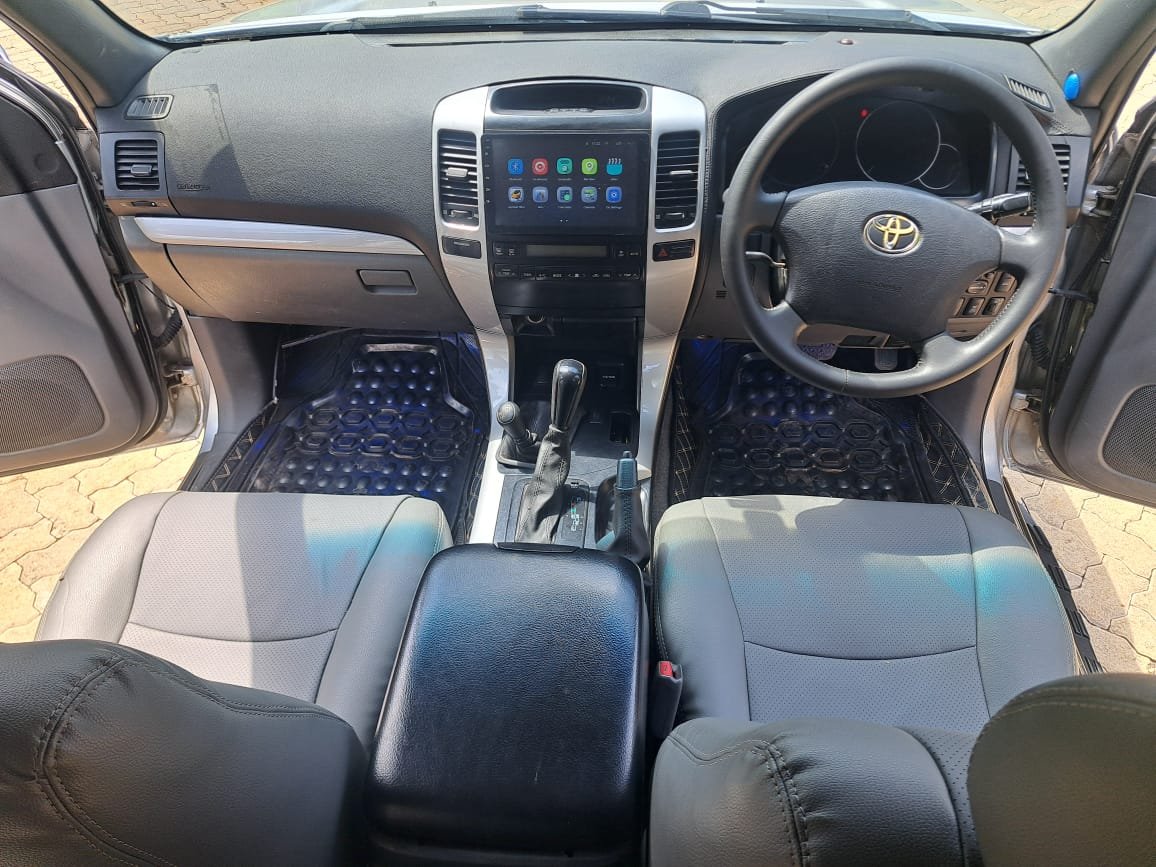
Reliability that’s more than a slogan
The J120 is built on Toyota’s Land Cruiser ethos. With consistent servicing and quality parts, these cars frequently cross the 300,000 km mark without drama. The engines and transmissions—especially when not abused—age gracefully. That reliability translates to fewer surprises and stronger resale value.
Off-road and “bad-road” capability
Kenya’s mix of tarmac, murram, washboard roads, and seasonal mud calls for proper 4×4 engineering. The J120’s ladder frame, full-time 4WD (in many trims), low-range, and generous ground clearance make it more than a city SUV. Whether you’re visiting the village or tackling rutted roads to a site, it keeps going without theatre.
Prestige and market respect
Like it or not, a Prado sends a message. It’s seen as serious, successful, and practical. That status factor matters to many buyers and helps keep resale values high. When it’s time to sell, a clean J120 draws interest quickly.
Easy to maintain locally
From Kirinyaga Road in Nairobi to shops in Mombasa, Nakuru, Eldoret, and Kisumu, parts and expertise are widespread. Options range from genuine OEM to high-quality aftermarket. The maintenance ecosystem around the Prado is one of its biggest advantages in Kenya.
4) Key Features to Know Before Buying
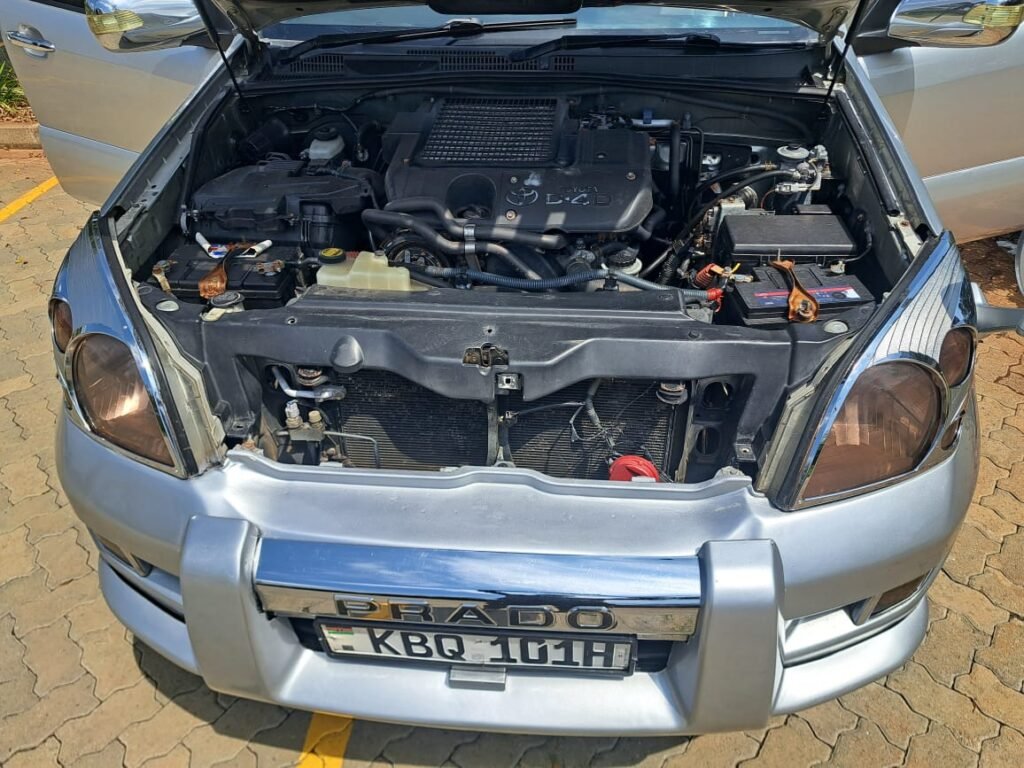
Engines, performance, and what they’re like to live with
| Engine | Type | What it’s like | Typical Pros | Typical Cons |
|---|---|---|---|---|
| 2.7L Petrol (2TR-FE) | 4-cyl petrol | Adequate for light duty, best in town | Simpler, cheaper to buy | Can feel underpowered on hills; middling economy |
| 3.4L Petrol (5VZ-FE) | V6 petrol | Smooth, proven design | Good refinement; reliable | Not as efficient; older units now |
| 4.0L Petrol (1GR-FE) | V6 petrol | Strongest petrol option, smooth & quiet | Punchy performance; great for towing | Thirsty, higher fuel budget |
| 3.0L Turbo Diesel (1KD-FTV) | 4-cyl diesel | Torquey, good for long distances | Better fuel economy; strong low-end | Sensitive to fuel quality; injector care is vital |
Real-world fuel economy (driving style, terrain, and load will change this):
- Petrol: roughly 6–8 km/l.
- Diesel: roughly 9–12 km/l.
Ride and comfort
The J120 is not limousine-soft, but it’s composed. Steering is light enough for city work; the high seating position boosts confidence. Road and wind noise are reasonable for its era. The 7-seat layout suits family logistics—though, like most SUVs, the third row is best for kids or short hops.
Cabin & feature set
Depending on trim and market spec, you may see: dual-zone climate control, leather upholstery, power seats, sunroof, rear A/C, premium audio, factory navigation (often outdated locally), reverse camera, and parking sensors. Most owners appreciate the straightforward ergonomics—buttons and knobs you can use without a PhD.
Safety
ABS, airbags (front in lower trims, more in higher trims), and stability control on many units. Remember: it’s an early-2000s design, so judge safety features relative to that era.
5) What to Check Before Buying a Used Prado J120
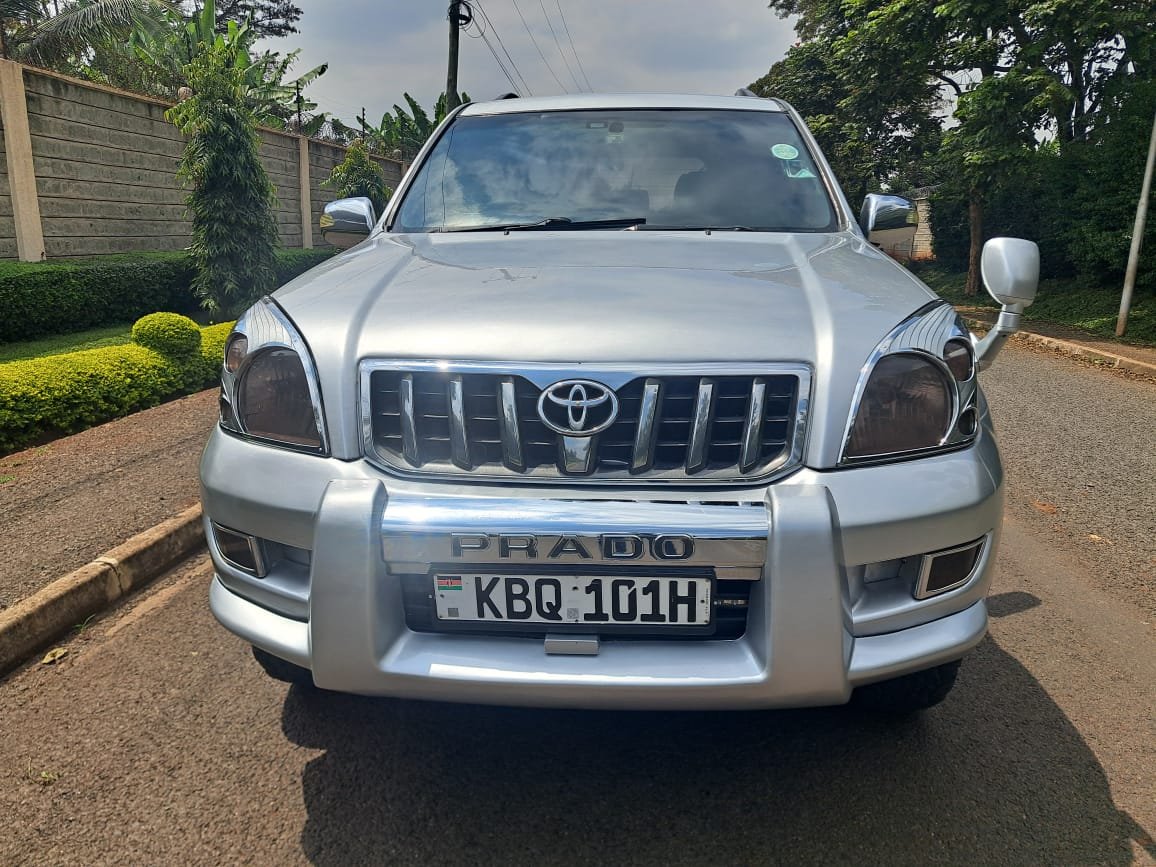
A careful inspection separates a gem from a gamble. Use this checklist and bring an independent mechanic if possible.
A) Documentation and history
- Logbook verification (NTSA): Ensure the seller’s story matches the records.
- Service records: Look for consistent oil changes, injector work on diesels, and timing/aux belts where applicable.
- Import records: If a fresh import, check auction sheets (if available), mileage consistency, and port/clearing paperwork.
- Chassis number: Confirm it matches the logbook and stamped chassis.
B) Engine health
- Cold start behaviour: It should start quickly, idle evenly, and avoid excess smoke.
- Smoke colour: Blue hints oil burning, black suggests over-fueling (injectors/tuning), white can indicate coolant issues.
- Leaks: Check under the engine, around the head cover, front and rear main seals.
- Overheating history: Any signs of coolant residue, top-ups, or unexplained recent radiator work? Ask direct questions.
C) Fuel system (especially diesels)
- Injector tick / rough idle: Diesels with worn injectors can idle roughly or knock.
- Fuel economy: Unusually poor economy may indicate injector or sensor issues.
- Injector correction values: A Toyota specialist can scan and read these; it’s worth paying for.
D) Transmission and driveline
- Automatic gearbox: Should shift smoothly without flares or harsh thumps.
- 4×4 system: Confirm high/low range engages; listen for clunks.
- Diff and transfer case: Look for leaks and unusual noises on load.
E) Suspension and steering
- Bushings & ball joints: On Kenyan roads these wear. Clunks over bumps usually signal attention needed.
- Shocks: Bounce the car at each corner; excessive pogoing means tired dampers.
- Alignment & tyres: Uneven wear suggests alignment or suspension issues. Confirm tyre age (DOT code) and brand.
F) Brakes and wheels
- Discs & pads: Look for grooves, lips, or vibration under braking (warped discs).
- Handbrake: Should hold firmly on an incline.
- ABS lights: Ensure no warning lights are masked or ignored.
G) Body and frame
- Rust check: Pay attention to underbody, door sills, tailgate edge, and radiator support.
- Panel gaps & overspray: Inconsistent gaps or overspray hints at crash repairs.
- Chassis straightness: A specialist can check if the frame is true—critical on body-on-frame SUVs.
H) Interior & electrics
- A/C performance: Warm air or fluctuating temps can signal compressor or blend-door issues.
- Dash condition: Older Prados may have dashboard cracks; not fatal, but leverage for negotiation.
- Switchgear: Test windows, mirrors, seat motors, central locking, sunroof, audio, and 12V sockets.
- Instrument cluster: No persistent warning lights; check bulb test on ignition (bulbs shouldn’t be removed to hide faults).
I) Road test routine (15–20 minutes minimum)
- City crawl: Listen for low-speed clunks, steering feel, brake bite.
- Open road: Does it track straight? Any vibrations at 80–110 km/h?
- Hard acceleration: Any slipping in the gearbox or misfiring?
- Emergency stop: Check stability and pedal feel.
- Tight turns: Creaks or groans can indicate CVs/suspension wear.
Pro tip: Pay for a pre-purchase inspection at a reputable 4×4 garage or Toyota dealer. The small fee can save you hundreds of thousands later.
6) Common Problems to Watch Out For
No model is perfect. Knowing typical J120 pain points helps you budget and negotiate wisely.
A) Fuel thirst (petrol)
The 4.0 V6 (1GR-FE) is smooth and strong—but not shy at the pump. If your routine is mostly short Nairobi hops in traffic, be realistic about consumption (often 6–7 km/l). On the highway at steady speeds it improves, but planning a fuel budget is essential.
B) Diesel injector wear (1KD-FTV)
Beloved for its torque and economy, the 1KD diesel needs clean fuel and correct servicing. Poor fuel, extended intervals, or cheap filters can shorten injector life. Signs include hard starts, rough idle, smoke, or diesel knock. Budget for inspection and potential injector refresh on higher-mileage units.
C) Suspension wear
Kenyan roads are hard on bushings, ball joints, stabilizer links, and shocks. The good news: parts are readily available. The bill can climb if you do everything at once, but the car feels “new” again after a thorough refresh.
D) Electrical gremlins (age-related)
Older J120s can develop quirks: intermittent window switches, tired alternators, sensor oddities, or HVAC blend door glitches. Usually solvable, but scan tools and patient troubleshooting help.
E) Cooling system neglect
Aging radiators, clogged cores, tired hoses, and failing water pumps can cause hot running. Ask about coolant changes (not just water top-ups), any radiator replacements, and whether the fan clutch is healthy.
F) Air suspension (certain high trims/markets)
Some premium-spec units have rear air suspension. It rides nicely but adds complexity. Check for sagging after the car sits overnight, compressor noise, or uneven ride height. Conversions to coil springs are common if air components get expensive.
Bottom line: None of these are deal-breakers if priced fairly. What you want is an honest car with evidence of care—or a realistically cheap car that leaves room in your budget for a catch-up service and known fixes.
7) Market Prices in Kenya & The Real Cost to Own
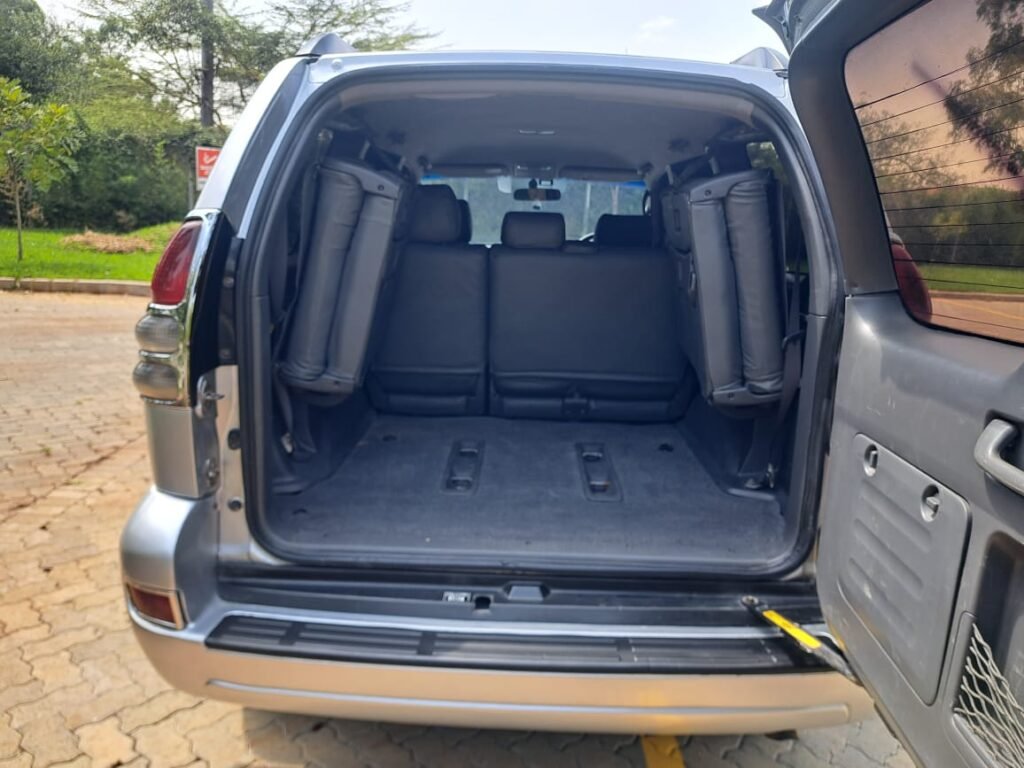
Prices vary with year, trim, mileage, condition, and whether it’s a local used unit or a fresh import.
A) Typical asking prices (indicative)
| Year of Manufacture | Common Trims | Typical Asking Price (KES) | What you’re likely getting |
|---|---|---|---|
| 2002–2004 | TX / TX-L | 1.6M – 2.2M | Higher mileage, basic-mid spec, variable history |
| 2005–2006 | TX / TZ | 2.3M – 2.8M | Mid-spec, moderate mileage, cleaner interiors |
| 2007–2009 | TZ-G / VX / VX-L | 3.0M – 4.5M | Later facelift, premium trims, often import-fresh |
Use these bands as starting points—condition trumps year. A meticulously serviced 2005 can be a better buy than a rough 2008.
B) Running costs snapshot
| Cost Item | Diesel (1KD) Estimate | Petrol (V6) Estimate | Notes |
|---|---|---|---|
| Routine service (annual) | 60k – 120k | 60k – 120k | Fluids, filters, minor wear items |
| Fuel (urban-heavy month) | 18k – 30k | 25k – 40k | Heavily depends on commute and driving style |
| Insurance (comprehensive) | 80k – 150k | 80k – 150k | Based on value, driver profile, insurer |
| Suspension refresh (once-off) | 70k – 180k | 70k – 180k | Bushings/links/ball joints; brand-dependent |
| Injector service (diesel) | 80k – 200k | — | Diagnostic-dependent; not every year |
TCO tip: When you buy, set aside a post-purchase “peace-of-mind fund” (e.g., 100k–250k) for catch-up maintenance. Doing fluids, filters, alignment, and any small fixes immediately sets a strong baseline.
8) Prado J120 vs. Alternatives
If you’re shopping widely, these rivals often come up.
| Model | Strengths | Trade-offs | Kenyan Reality Check |
|---|---|---|---|
| Land Cruiser 100 Series | Bigger, ultra-tough, prestige | Heavier, thirstier, pricier to run | Brilliant for long expeditions; overkill for many daily users |
| Mitsubishi Pajero | Capable 4×4, often cheaper to buy | Resale weaker; parts ecosystem smaller than Toyota | A good value play if you find a well-kept one |
| Nissan Patrol (Y61) | Rugged, legendary off-road | Poor economy; not as refined | Fantastic off-road toy, but daily costs add up |
| Toyota Fortuner | Newer options at same money; decent economy | Ladder-frame ride is firmer; less prestige | If you value newer MY and warranty, Fortuner tempts; Prado still wins on badge and resale |
Why choose the J120?
It strikes a sweet spot: real 4×4 hardware, comfortable cabin, strong brand pull, and a deep local support network. Unless you specifically need the brute size of a 100 Series or want a newer Fortuner with warranty, the J120 remains the “just right” choice for many Kenyan buyers.
9) Smart Buying Tips for the Kenyan Market
1) Start with the seller
- Reputable dealers or well-documented private sellers reduce risk.
- Be wary of “urgent sale” pressure and too-good-to-be-true pricing.
- Check the seller’s consistency: how long have they had the car? Does the story align with records?
2) Verify everything
- NTSA for logbook and ownership.
- Service records (receipts, stamps, workshop names).
- Chassis/engine numbers match physical stamps and documents.
- If a fresh import, try to see the auction sheet and check mileage consistency across documents.
3) Pay for an independent inspection
Even if the car “drives fine,” a specialist 4×4 inspection often uncovers hidden wear (bushings, leaks, mounts, impending injector work). Use findings to negotiate or to walk away.
4) Test properly
Drive on city roads, a rough patch, and an open stretch up to highway speeds. Test every switch. Cycle the 4×4 system. Brake firmly once. Listen. Feel. A rushed five-minute spin around the block is not a test.
5) Budget beyond the sticker price
Remember insurance, transfer fees, initial service, tyres, and small fixes. A car with a lower sticker but neglected maintenance can cost more than a slightly pricier, properly kept unit.
6) Watch out for the usual tricks
- Mileage tampering exists. Cross-check with service stickers, past inspection reports, or import records.
- Cosmetic “flips” (fresh paint, detailed engine bays) can hide issues—look underneath.
- Masking warning lights by removing bulbs is rare but happens; confirm all bulbs self-test on ignition.
7) Negotiate with data
Arrive with comparable listings, inspection results, and a clear budget. If the seller won’t move and the numbers don’t make sense, be ready to leave. There’s always another Prado.
10) Final Verdict
The Toyota Prado J120 remains one of Kenya’s most sensible used luxury-SUV buys. It’s comfortable, genuinely capable, respected in the market, and—crucially—supported by a vast local maintenance ecosystem. Yes, petrol variants drink, and diesels demand injector vigilance. Yes, suspensions wear on our roads. But these are predictable, manageable realities with transparent pricing and abundant parts.
If you prioritize condition and history over year and trim, set aside a post-purchase maintenance fund, and insist on a proper inspection, a J120 can serve your family or business for years while holding value. For many Kenyan buyers, it’s still the SUV that “just works.”
11) FAQs (Kenya-focused)
Q1: Diesel or petrol—what should I choose?
If you do longer trips, carry loads, or want better economy, the diesel (1KD-FTV) makes sense—provided you commit to clean fuel, timely filter changes, and injector checks. If your use is mostly short city hops and you prefer silkier power with fewer diesel-specific concerns, a petrol V6 suits you—budget more for fuel.
Q2: What’s a sensible mileage limit for a used J120?
Mileage alone isn’t decisive. A 220,000-km car with verifiable service may be safer than a 120,000-km car with gaps and a suspiciously shiny engine bay. Prioritize history, inspection results, and how it drives.
Q3: How expensive is it to “reset” a neglected suspension?
Parts vary widely by brand, but budgeting 70k–180k for a thorough refresh (bushings, links, ball joints, shocks) is reasonable. Doing it once, properly, often transforms the car.
Q4: Are parts easy to find upcountry, or only in Nairobi?
Nairobi has the deepest stock, but Mombasa, Nakuru, Eldoret, Kisumu and other towns have healthy supply chains. For rare items, Nairobi suppliers can ship overnight. You’re not stranded.
Q5: Is the third row practical?
Yes for kids and short adults, fine for occasional use by full-size adults. If you frequently carry seven adults, you’ll want the middle row slid forward and pragmatic expectations.
Q6: How do I check for air-suspension trouble (if fitted)?
Park on level ground overnight. If the rear sags by morning, you might have leaks or tired bags/valves. Listen for a compressor that runs frequently. A scan can read height sensor data. Many owners convert to coils if upkeep gets expensive.
Q7: What preventive maintenance should I do right after buying?
- Engine oil & filter, gear oils, diff & transfer case fluids
- Coolant flush, check hoses and clamps
- Fuel filter (critical on diesels)
- Brake fluid and inspect pads/discs
- Air & cabin filters
- Wheel alignment and balancing, tyre inspection/replacement if needed
Starting with fresh fluids gives you a known baseline.
Q8: How strong is the resale value really?
Among used SUVs in Kenya, Prado is near the top for liquidity and value retention. A clean, well-serviced J120 sells faster and closer to asking than many rivals—one reason buyers accept slightly higher upkeep costs.
Q9: Can I tow and carry heavy loads with a J120?
Yes—within manufacturer tow specs and with a healthy cooling system and brakes. The diesel is naturally better for sustained towing thanks to torque, but many owners tow with the 4.0 V6 comfortably.
Q10: What’s the single best way to avoid buying a bad one?
Pay for an independent pre-purchase inspection at a workshop that knows Prados. It’s the highest-ROI step in the entire process—more valuable than any clever negotiation trick.
Related posts


The Heart of Your Car: A Deep Dive into Transmissions


The Ultimate Family SUV? A Review of the Toyota Prado J150


Cars Under 1000cc in Kenya


